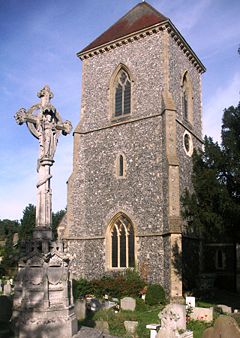Addington, London
| Addington | |
|---|---|
 St Mary's Church |
|
| Addington shown within Greater London | |
| OS grid reference | TQ375645 |
| • Charing Cross | 11.1 mi (17.9 km) NNW |
| London borough | |
| Ceremonial county | Greater London |
| Region | |
| Country | England |
| Sovereign state | United Kingdom |
| Post town | CROYDON & SOUTH CROYDON |
| Postcode district | CR0 & CR2 |
| Dialling code | 01689 |
| Police | Metropolitan |
| Fire | London |
| Ambulance | London |
| EU Parliament | London |
| UK Parliament | |
| London Assembly | |
Addington is an area of south London, England, located in the London Borough of Croydon. It is situated 11.1 miles (18 km) south south-east of Charing Cross.
In ancient days named Edintona, then Eddintone. The village lay within the Anglo-Saxon administrative division of Wallington hundred. Addington is thought to be named after Edda, a Saxon. In the Domesday Book, two manors are mentioned, linked with the names Godric and Osward.
Addington Place, later known as Addington Farm and now called Addington Palace, dominates the village above the church of St Mary the Blessed Virgin Church and The Cricketers pub. The manor house was situated behind the church and was the residence of the Leigh family. From this Leigh family, Patricia Knatchbull, 2nd Countess Mountbatten of Burma is believed to be descended. There is an oft repeated, but false account of a royal hunting lodge, "where King Henry VIII supposedly wooed Anne Boleyn, whose family owned nearby Wickham Court" by West Wickham Parish Church. However, the Anne Boleyn of Wickham Court was the aunt of Queen Anne.
The Palladian mansion was built in the mid-18th century by Barlow Trecothick, from Boston, Massachusetts in the United States, who returned to England and became an MP and Lord Mayor of the City of London in 1770. After his death without heirs, his nephew James Ivers (later Trecothick), also of Boston, continued his uncle's work and had the grounds laid out by Lancelot Brown. The estate was sold and eventually, as Croydon Palace became too inconvenient and unsanitary, the Addington house and part of the estate was bought for the Archbishops of Canterbury as a country residence. The last Archbishop to use it was Archbishop Benson.
...
Wikipedia

